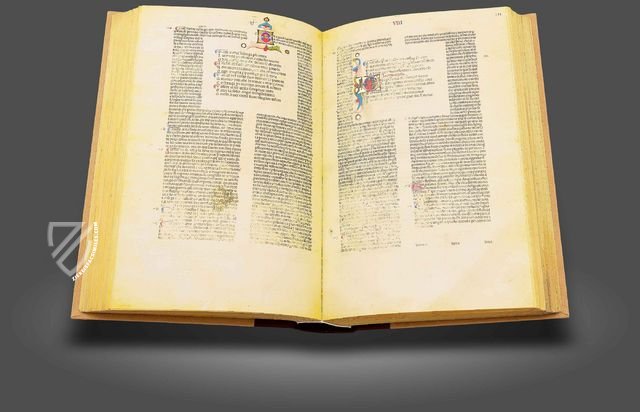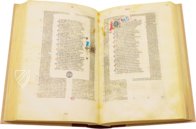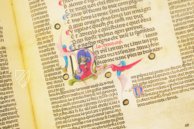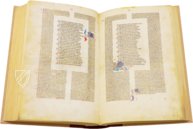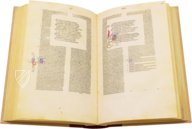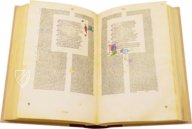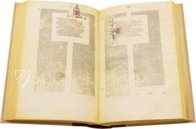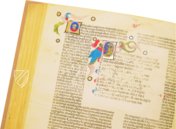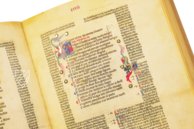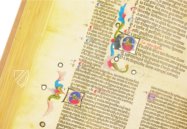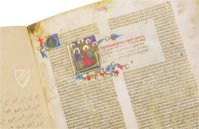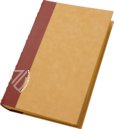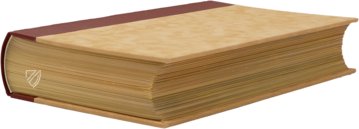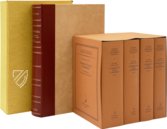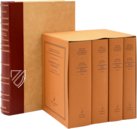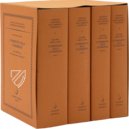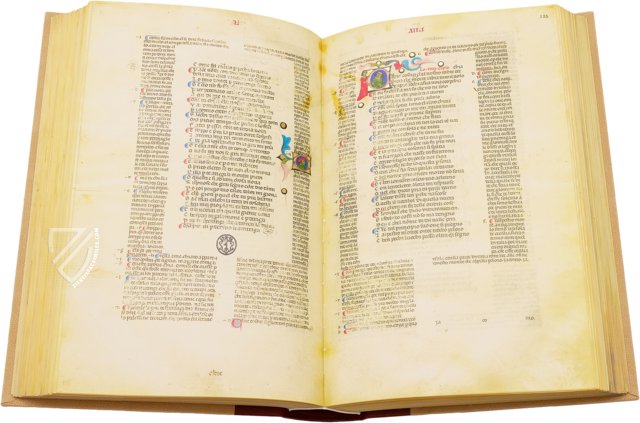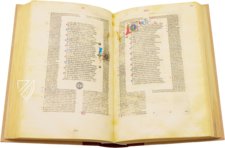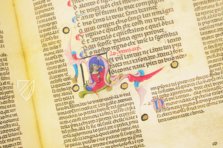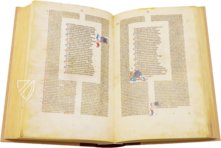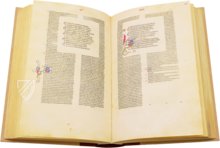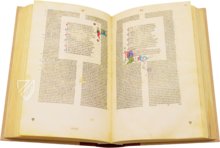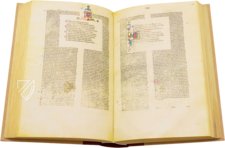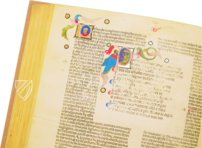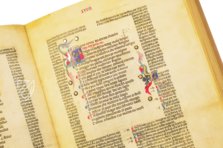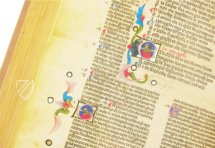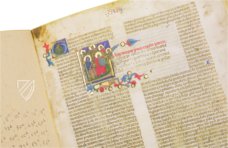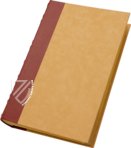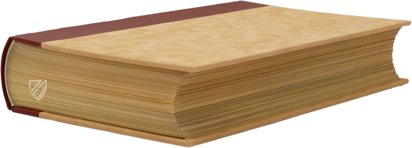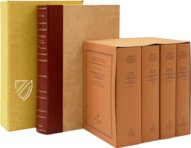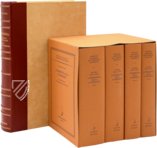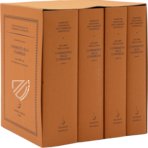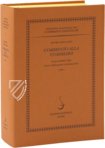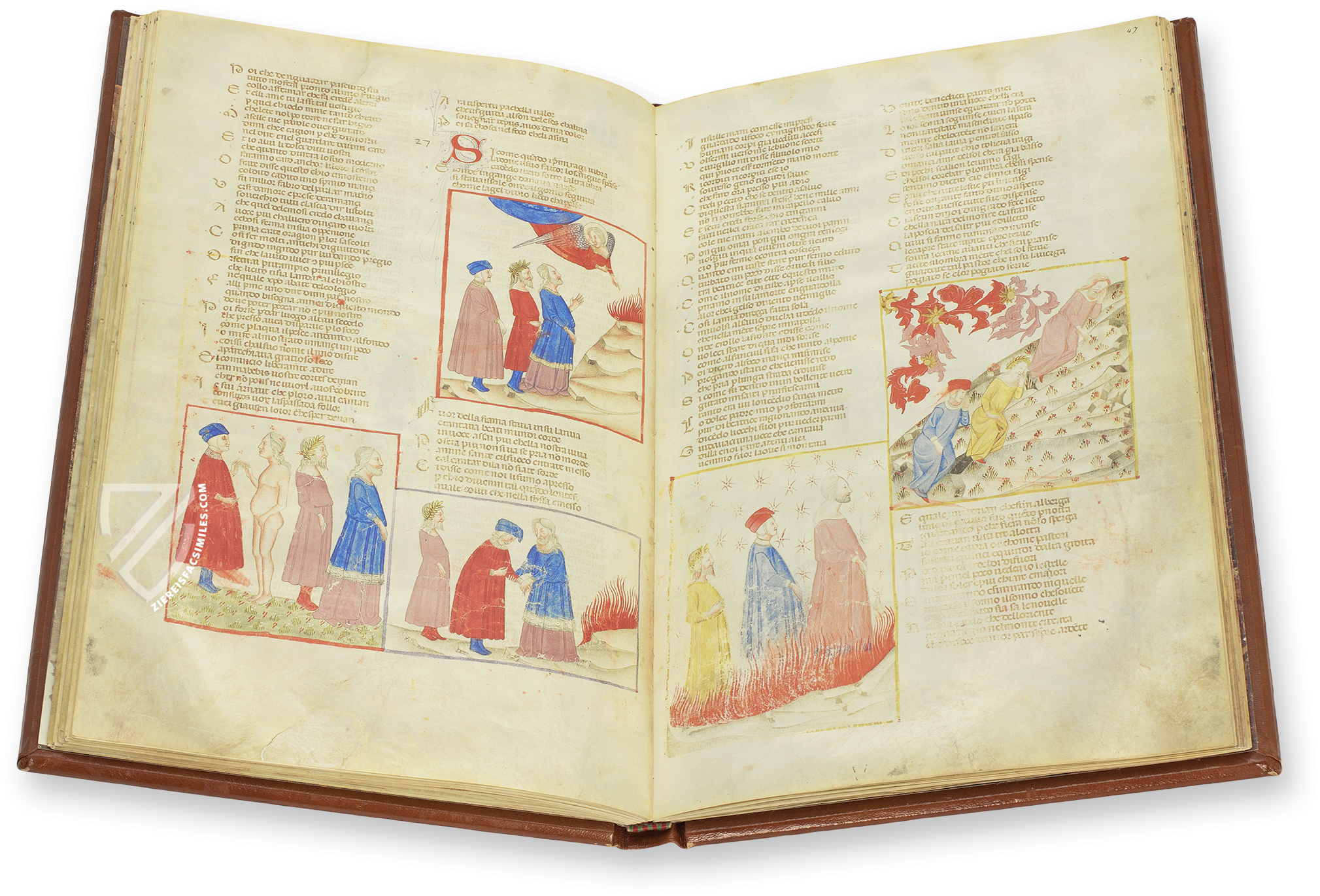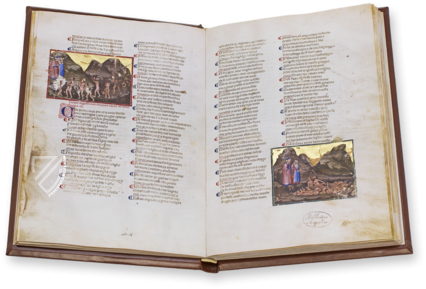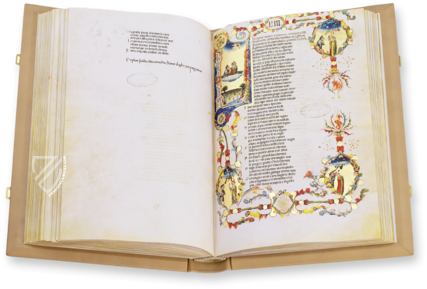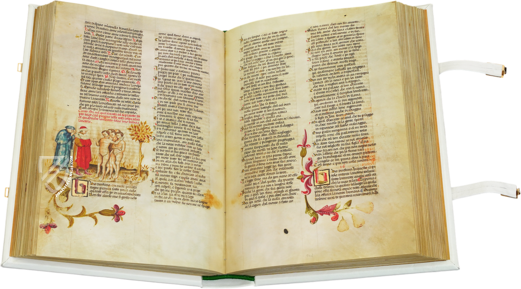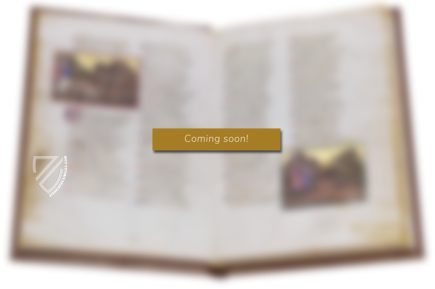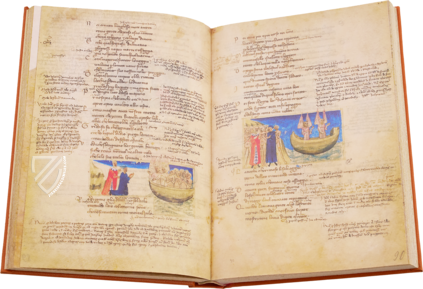Divine Comedy - Florence-Milan Manuscript
(1,000€ - 3,000€)
The Codex Riccardiano-Braidense not only contains one of the oldest surviving copies of the famous Divine Comedy by Dante Alighieri (1265–1321), but is above all one of the most important and most beautiful specimens of the exegetical commentary on the work by Jacopo della Lana (after 1278 – after 1358). It is the first comprehensive commentary on all 100 cantos, which, due to its immediate success, was later even included in the Ottimo Commento, the “Excellent Commentary” – a true bestseller of medieval Dante interpretation. Created in the second quarter of the Trecento in Veneto, the manuscript takes its name from its current repositories: the first two parts containing the Inferno and Purgatorio are kept in the Biblioteca Riccardiana, while the Paradiso is in the Biblioteca Nazionale Braidense. All three parts are calligraphic masterpieces with a total of 199 historiated initials decorated in gold and countless ornamental initials.
Divine Comedy - Florence-Milan Manuscript
The Divine Comedy is the famous major work of the Italian poet Dante Alighieri (1265–1321). He worked for over 10 years on this piece of world literature consisting of 100 cantos, which is an allegory for the soul's search for God. In three parts of about equal length, Dante undertakes a literary journey in the first person through the three realms of the world beyond: Hell (Inferno), Purgatory (Purgatorio) and Paradise (Paradiso). He encounters numerous historical, biblical and mythological figures along the way. His guide through the first two books is Virgil, who he truely admires. However, as he comes from pre-Christian times and is therefore not baptized, he is replaced in Paradise by Beatrice, who represents Dante's ideal of women, and later Bernhard of Clairvaux.
An Unusual Layout
The 14,233 verses of this poetic masterpiece usually take up the least space on the individual pages of the Florentine-Milan manuscript. They were placed in a single column and centrally on the parchment, with many pages often containing only a few verses. The frame of the poem is formed here in several respects by a two-column gloss, which accurately encloses the verses from left and right, as was more common for legal texts at the time. These extensive marginal glosses are not spontaneous annotations for study purposes. They were planned into the layout of the manuscript from the outset and contain the first comprehensive commentary on the Divine Comedy.
Trecento Dante Exegesis
Jacopo della Lana (after 1278 – after 1358) wrote his commentary between 1324 and 1328, just a few years after the poem was completed and not long before the present copy was produced. He was inspired by his two predecessors Jacopo Alighieri and Graziolo Bambaglioli, who, however, only partially glossed Dante's work. Moreover, Jacopo did not limit himself to a literal interpretation of the verses, but subjected them to a philosophical-theological reading - entirely in keeping with his own university education. His commentary also enjoyed immediate and lasting success through the use of the Italian vernacular.** Entire passages of the commentary were later included in the so-called Ottimo Commento or “Excellent Commentary”.
The Work of a Virtuoso Scribe
Particularly remarkable about the Florence-Milan Manuscript is the accuracy with which the poem and commentary were brought together. Especially in the first two parts of the manuscript, Inferno and Purgatorio, the pages were planned so meticulously that usually not a single line is left blank. A master named Galvano was responsible for this masterpiece of calligraphic art in Gothic textura rotunda. He immortalized himself on fol. 100r: “Maestro Galvano wrote el testo e la ghiosa. Mercede quella Vergene gloriosa.” It is disputed among scholars whether this refers to Galvano di Rinaldo da Vigo, who worked in Bologna, or Galvano di Tommaso da Bologna, who died in Padua in 1347.
Significant Initial in Vibrant Colors and Gold
Both the verses of the Divine Comedy and the glosses are decorated throughout the manuscript with golden Trecento initials, 199 of them historiated. While those in the glosses mostly show generic author pictures, the images accompanying the cantos usually open up a further level of meaning, as they do not simply illustrate what is being narrated. In the first two parts, for example, the sins that led the souls to the horrific places that Dante and Virgil traverse are often visualized. However, many initials also show biblical iconographies, which in turn take up Jacopo della Lana's exegesis of the work.
Codicology
- Alternative Titles
- Il manoscritto Riccardiano-Braidense della Commedia di Dante Alighieri
Göttliche Komödie - Codex Riccardiano-Braidense
Dante Riccardiano-Braidense - Size / Format
- 572 pages / 33.0 × 21.0 cm
- Origin
- Italy
- Date
- Second quarter of the 14th century
- Epochs
- Style
- Genre
- Language
- Script
- Gothic Textura Rotunda
- Illustrations
- 199 historiated initials with foliate extenders; numerous smaller ornamental initials
- Content
- Dante's Divine Comedy accompanied by the commentary by Jacopo della Lana
- Artist / School
- Dante Alighieri (ca. 1265 – 1321) (author)
Jacopo della Lana (ca. 1290 – ca. 1365) (author)
Galvano (scribe) - Previous Owners
- Monastery of Santa Giustina
Divine Comedy - Florence-Milan Manuscript
Christ Destroys the Gates of the Underworld
The 17th canto of the Purgatorio - Dante and Virgil are here on the fourth terrace of Purgatory - is about love, which can lead to sinfulness if misguided. However, love, namely the love of God, is also the key to salvation in the Christian faith. This level is added to the canto by means of this historiated initial 'P'. Christ stands with a bent leg on the lower extender of the letter, while he lifts the gate to the underworld from its hinges, from which the first liberated soul is already peeking out.
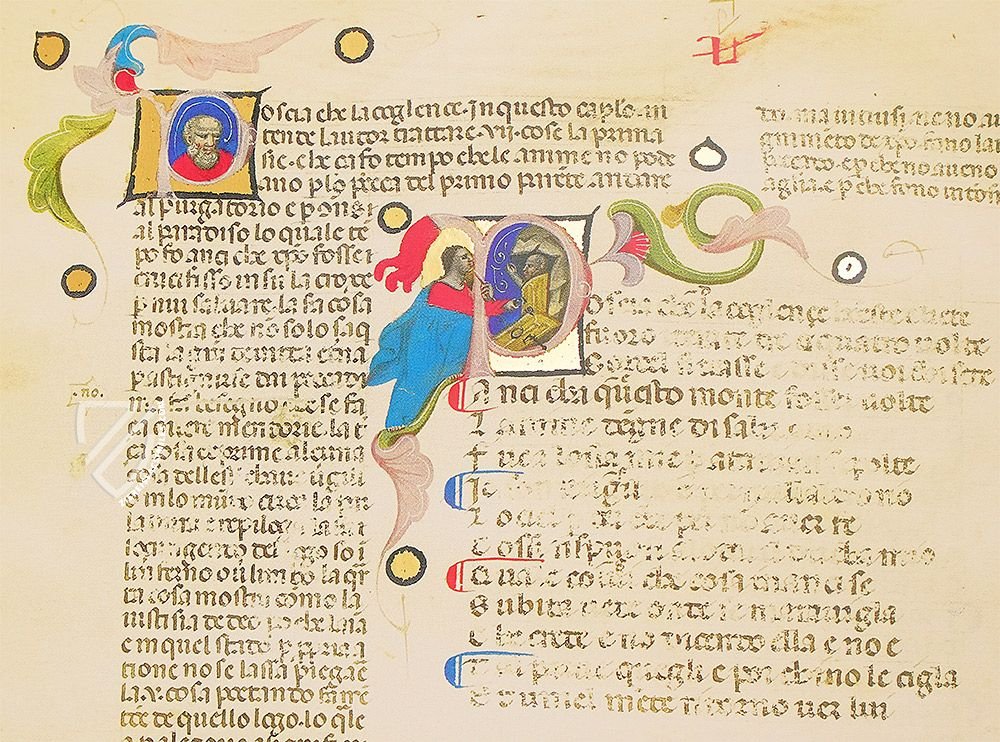
Divine Comedy - Florence-Milan Manuscript
Coronation of Mary
It is no coincidence that at the beginning of the first canto of the Paradiso there is a large historiated initial 'L' depicting the heavenly coronation of the Virgin Mary by Christ. As usual, the two are seated next to each other at eye level. Mary is wrapped in her typical blue cloak, while Christ places the crown on her head - which is barely visible here due to abrasion and the lavish golden nimbus. Behind mother and son, four angels stretch a large textile creating the background of the scene and therefore lending it even more royal splendor.
In the third part of the Divine Comedy, Mary is repeatedly venerated as the Queen of Heaven and appears as an exemplary identification figure as well as the most important mediator between man and God, between earth and heaven. She is also the central figure who ultimately helps Dante to experience his vision of the Trinity. The initial artfully introduces this content.
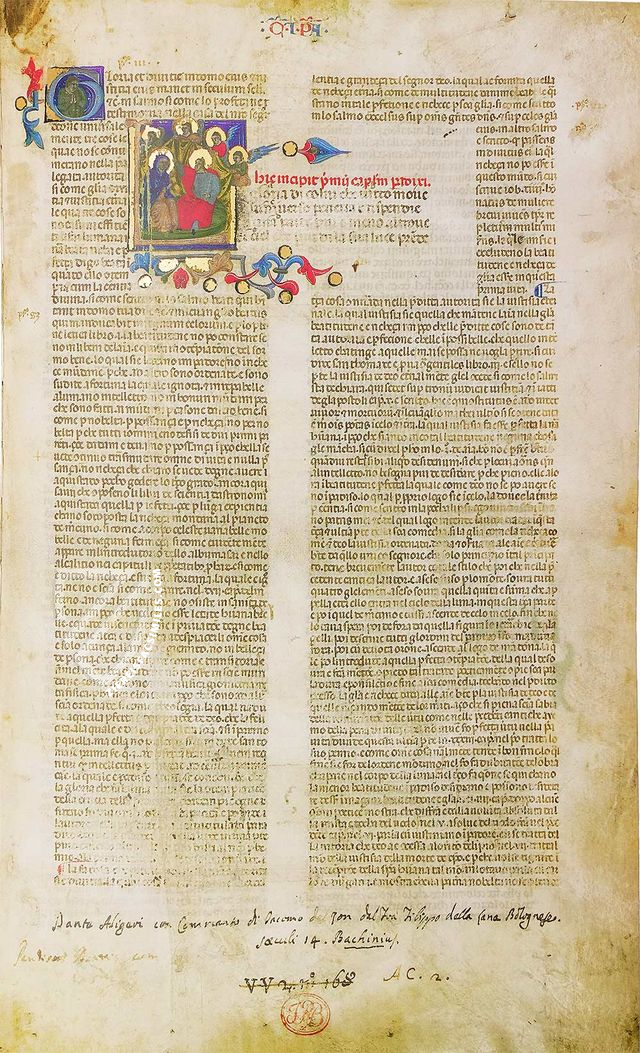
#1 Il Manoscritto Riccardiano-Braidense della Commedia di Dante Alighieri
Language: Italian
(1,000€ - 3,000€)
- Treatises / Secular Books
- Apocalypses / Beatus
- Astronomy / Astrology
- Bestiaries
- Bibles / Gospels
- Chronicles / History / Law
- Geography / Maps
- Saints' Lives
- Islam / Oriental
- Judaism / Hebrew
- Single Leaf Collections
- Leonardo da Vinci
- Literature / Poetry
- Liturgical Manuscripts
- Medicine / Botany / Alchemy
- Music
- Mythology / Prophecies
- Psalters
- Other Religious Books
- Games / Hunting
- Private Devotion Books
- Other Genres
- Afghanistan
- Armenia
- Austria
- Belgium
- Belize
- Bosnia and Herzegovina
- China
- Colombia
- Costa Rica
- Croatia
- Cyprus
- Czech Republic
- Denmark
- Egypt
- El Salvador
- Ethiopia
- France
- Germany
- Greece
- Guatemala
- Honduras
- Hungary
- India
- Iran
- Iraq
- Israel
- Italy
- Japan
- Jordan
- Kazakhstan
- Kyrgyzstan
- Lebanon
- Liechtenstein
- Luxembourg
- Mexico
- Morocco
- Netherlands
- Palestine
- Panama
- Peru
- Poland
- Portugal
- Romania
- Russia
- Serbia
- Spain
- Sri Lanka
- Sweden
- Switzerland
- Syria
- Tajikistan
- Turkey
- Turkmenistan
- Ukraine
- United Kingdom
- United States
- Uzbekistan
- Vatican City
- A. Oosthoek, van Holkema & Warendorf
- Aboca Museum
- Ajuntament de Valencia
- Akademie Verlag
- Akademische Druck- u. Verlagsanstalt (ADEVA)
- Aldo Ausilio Editore - Bottega d’Erasmo
- Alecto Historical Editions
- Alkuin Verlag
- Almqvist & Wiksell
- Amilcare Pizzi
- Andreas & Andreas Verlagsbuchhandlung
- Archa 90
- Archiv Verlag
- Archivi Edizioni
- Arnold Verlag
- ARS
- Ars Magna
- ArtCodex
- AyN Ediciones
- Azimuth Editions
- Badenia Verlag
- Bärenreiter-Verlag
- Belser Verlag
- Belser Verlag / WK Wertkontor
- Benziger Verlag
- Bernardinum Wydawnictwo
- BiblioGemma
- Biblioteca Apostolica Vaticana (Vaticanstadt, Vaticanstadt)
- Bibliotheca Palatina Faksimile Verlag
- Bibliotheca Rara
- Boydell & Brewer
- Bramante Edizioni
- Bredius Genootschap
- Brepols Publishers
- British Library
- C. Weckesser
- Caixa Catalunya
- Canesi
- CAPSA, Ars Scriptoria
- Caratzas Brothers, Publishers
- Carus Verlag
- Casamassima Libri
- Centrum Cartographie Verlag GmbH
- Chavane Verlag
- Christian Brandstätter Verlag
- Circulo Cientifico
- Club Bibliófilo Versol
- Club du Livre
- CM Editores
- Collegium Graphicum
- Collezione Apocrifa Da Vinci
- Comissão Nacional para as Comemorações dos Descobrimentos Portugueses
- Coron Verlag
- Corvina
- CTHS
- D. S. Brewer
- Damon
- De Agostini/UTET
- De Nederlandsche Boekhandel
- De Schutter
- Deuschle & Stemmle
- Deutscher Verlag für Kunstwissenschaft
- DIAMM
- Droz
- E. Schreiber Graphische Kunstanstalten
- Ediciones Boreal
- Ediciones Grial
- Ediclube
- Edições Inapa
- Edilan
- Editalia
- Edition Deuschle
- Edition Georg Popp
- Edition Leipzig
- Edition Libri Illustri
- Editiones Reales Sitios S. L.
- Éditions de l'Oiseau Lyre
- Editions Medicina Rara
- Editorial Casariego
- Editorial Mintzoa
- Editrice Antenore
- Editrice Velar
- Edizioni Edison
- Egeria, S.L.
- Eikon Editores
- Electa
- Emery Walker Limited
- Enciclopèdia Catalana
- Eos-Verlag
- Ephesus Publishing
- Ernst Battenberg
- Eugrammia Press
- Extraordinary Editions
- Fackelverlag
- Facsimila Art & Edition
- Facsimile Editions Ltd.
- Facsimilia Art & Edition Ebert KG
- Faksimile Verlag
- Feuermann Verlag
- Folger Shakespeare Library
- Franco Cosimo Panini Editore
- Friedrich Wittig Verlag
- Fundación Hullera Vasco-Leonesa
- G. Braziller
- Gabriele Mazzotta Editore
- Gebr. Mann Verlag
- Gesellschaft für graphische Industrie
- Getty Research Institute
- Giovanni Domenico de Rossi
- Giunti Editore
- Graffiti
- Grafica European Center of Fine Arts
- Guido Pressler
- Guillermo Blazquez
- Gustav Kiepenheuer
- H. N. Abrams
- Harrassowitz
- Harvard University Press
- Helikon
- Hendrickson Publishers
- Henning Oppermann
- Herder Verlag
- Hes & De Graaf Publishers
- Hoepli
- Holbein-Verlag
- Houghton Library
- Hugo Schmidt Verlag
- Idion Verlag
- Il Bulino, edizioni d'arte
- ILte
- Imago
- Insel Verlag
- Insel-Verlag Anton Kippenberger
- Instituto de Estudios Altoaragoneses
- Instituto Nacional de Antropología e Historia
- Introligatornia Budnik Jerzy
- Istituto dell'Enciclopedia Italiana - Treccani
- Istituto Ellenico di Studi Bizantini e Postbizantini
- Istituto Geografico De Agostini
- Istituto Poligrafico e Zecca dello Stato
- Italarte Art Establishments
- Jan Thorbecke Verlag
- Johnson Reprint Corporation
- Josef Stocker
- Josef Stocker-Schmid
- Jugoslavija
- Karl W. Hiersemann
- Kasper Straube
- Kaydeda Ediciones
- Kindler Verlag / Coron Verlag
- Kodansha International Ltd.
- Konrad Kölbl Verlag
- Kurt Wolff Verlag
- La Liberia dello Stato
- La Linea Editrice
- La Meta Editore
- Lambert Schneider
- Landeskreditbank Baden-Württemberg
- Leo S. Olschki
- Les Incunables
- Liber Artis
- Library of Congress
- Libreria Musicale Italiana
- Lichtdruck
- Lito Immagine Editore
- Lumen Artis
- Lund Humphries
- M. Moleiro Editor
- Maison des Sciences de l'homme et de la société de Poitiers
- Manuscriptum
- Martinus Nijhoff
- Maruzen-Yushodo Co. Ltd.
- MASA
- Massada Publishers
- McGraw-Hill
- Metropolitan Museum of Art
- Militos
- Millennium Liber
- Müller & Schindler
- Nahar - Stavit
- Nahar and Steimatzky
- National Library of Wales
- Neri Pozza
- Nova Charta
- Oceanum Verlag
- Odeon
- Orbis Mediaevalis
- Orbis Pictus
- Österreichische Staatsdruckerei
- Oxford University Press
- Pageant Books
- Parzellers Buchverlag
- Patrimonio Ediciones
- Pattloch Verlag
- PIAF
- Pieper Verlag
- Plon-Nourrit et cie
- Poligrafiche Bolis
- Presses Universitaires de Strasbourg
- Prestel Verlag
- Princeton University Press
- Prisma Verlag
- Priuli & Verlucca, editori
- Pro Sport Verlag
- Propyläen Verlag
- Pytheas Books
- Quaternio Verlag Luzern
- Reales Sitios
- Recht-Verlag
- Reichert Verlag
- Reichsdruckerei
- Reprint Verlag
- Riehn & Reusch
- Roberto Vattori Editore
- Rosenkilde and Bagger
- Roxburghe Club
- Salerno Editrice
- Saltellus Press
- Sandoz
- Sarajevo Svjetlost
- Schöck ArtPrint Kft.
- Schulsinger Brothers
- Scolar Press
- Scrinium
- Scripta Maneant
- Scriptorium
- Shazar
- Siloé, arte y bibliofilia
- SISMEL - Edizioni del Galluzzo
- Sociedad Mexicana de Antropología
- Société des Bibliophiles & Iconophiles de Belgique
- Soncin Publishing
- Sorli Ediciones
- Stainer and Bell
- Studer
- Styria Verlag
- Sumptibus Pragopress
- Szegedi Tudomànyegyetem
- Taberna Libraria
- Tarshish Books
- Taschen
- Tempus Libri
- Testimonio Compañía Editorial
- Thames and Hudson
- The Clear Vue Publishing Partnership Limited
- The Facsimile Codex
- The Folio Society
- The Marquess of Normanby
- The Richard III and Yorkist History Trust
- Tip.Le.Co
- TouchArt
- TREC Publishing House
- TRI Publishing Co.
- Trident Editore
- Tuliba Collection
- Typis Regiae Officinae Polygraphicae
- Union Verlag Berlin
- Universidad de Granada
- University of California Press
- University of Chicago Press
- Urs Graf
- Vallecchi
- Van Wijnen
- VCH, Acta Humaniora
- VDI Verlag
- VEB Deutscher Verlag für Musik
- Verlag Anton Pustet / Andreas Verlag
- Verlag Bibliophile Drucke Josef Stocker
- Verlag der Münchner Drucke
- Verlag für Regionalgeschichte
- Verlag Styria
- Vicent Garcia Editores
- W. Turnowski Ltd.
- W. Turnowsky
- Waanders Printers
- Wiener Mechitharisten-Congregation (Wien, Österreich)
- Wissenschaftliche Buchgesellschaft
- Wissenschaftliche Verlagsgesellschaft
- Wydawnictwo Dolnoslaskie
- Xuntanza Editorial
- Zakład Narodowy
- Zollikofer AG

